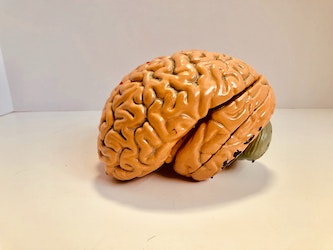Due to momentous neuroscientific breakthroughs over the last century, we now understand the human brain better than ever before in history. Alongside scientists and researchers, there is also an interest in knowledge of the brain among the public. Individuals use this information to help improve cognitive function, alleviate bodily issues or simply better their understanding of themselves.
Here at BrainZucker, we have gathered a compilation of some of the most fascinating facts about the human brain to get you started.
1. The human brain doesn't feel pain
Despite the fact that the brain is responsible for the detection and processing of pain throughout the rest of the body, it does not feel pain itself.
We experience pain when sensory nerve fibres called nociceptors are activated by harmful stimuli in the skin, muscles, joints and some organs. The nociceptors send electronic signals to the brain, where they are perceived and trigger a pain response.
However, brain tissue does not contain any nociceptors meaning external stimuli does not have the same effect. Researchers at Stanford University say this explains why neurosurgeons can perform brain surgery without anaesthesia, or even whilst the patient is still awake.
2. Napping can significantly improve the brain's performance
It is no surprise that good, regular sleep is integral to the health and functionality of your brain, however it is lesser-known that napping, in particular, has substantial benefits. Various studies have pointed towards the idea that napping can massively improve cognitive performance.
One study was conducted to evaluate the effect of napping on memory, in which people were asked to memorise illustrated cards and recall them after a 40-minute break. The participants were split into two groups; one group was asked to have a nap and the other stayed awake. It was recorded that the group that napped performed marginally better, remembering 85% of the cards in comparison to 60% in those that stayed awake.
Napping has been shown to solidify memories, as whilst in a light sleep, new information recorded in the hippocampus is pushed into the neocortex. This is the brain's more 'permanent' storage that holds more long-term memories.
3. Our brains are gradually shrinking
According to research, the volume of our brains has been declining for the last 20,000 years. Human beings have lost a significant percentage of brain mass, with males losing a tennis ball-sized amount of brain tissue and women losing the same amount proportionally.
Concerningly, as the brain has shrunk, so have our attention spans. Between the year 2000 and 2015, scientists have discovered that the average attention span has decreased by more than 30%, from 12 seconds to 8.25 seconds. Some people have concluded that this is a result of our more efficient environment, whilst others believe our shrinking brains are a sign of humanity evolving to become less intelligent.
4. Brain size has no real effect on intelligence
Those with bigger brains are not necessarily more intelligent than those with smaller brains. On average the human brain is around 15 centimetres long and 1.4 kilograms, 85% of which is made up of the cerebrum which is involved in learning, emotions, reasoning and problem-solving. Men's brains are also generally larger than women's.
Although a decrease in certain parts of the brain proportionally has been known to cause certain impairments, research has never found any significant correlation between the size of the brain and higher intelligence. Brain dimensions are only thought to contribute towards 10% of variability.
5. The brain is mostly water
Much like the rest of the body, the majority of the human brain is made up of water. It is estimated that it makes up around 75% of the brain, and is responsible for around 2% of the body's overall water content.
Drinking water regularly is incredibly important to ensure optimal brain function. Studies have shown that a dehydration level of a little of 2% can cause notable problems with attention, memory skills and other cognitive functions.
6. Meditation can 'rewire' your brain
Meditation is a widely used holistic approach to support general well-being and stress reduction, however, it may have more benefits than previously thought. It has been scientifically proven that meditation can alter brain function resulting in alleviated anxiety.
Meditation can loosen specific neural pathways that trigger negative emotions. When we experience something alarming, the fear centre of the brain sends signals to the medial prefrontal cortex. The mPFC is the part of our brains that processes information relating to our experiences, and particularly upsetting experiences trigger a strong emotional response.
During the process of meditation, the neural pathways between the fear centre and the mPFC are weakened, whilst simultaneously connections between the fear centre and the parts of our brain that deal with reasoning are strengthened. This allows us to deal with scary situations more calmly and rationally.
7. The majority of the human brain is utilised
There is a widely held belief that just 10% of the human brain is actively used. It is unclear how this myth arose, but a survey conducted in 2013 deduced that 65% of Americans thought this was factual.
Neurologist Barry Gordon explained that this is untrue, and in fact, the majority of the brain is active at almost all times, including sleep and rest. Various techniques, such as the use of functional magnetic resonance imaging to monitor neural activity, have recorded findings that correctly correspond with Gordon's statement.
The facts presented here are just a minute fraction of the expansive information on the human brain available to us today. As a result of the brain's complexity, it is unlikely that research regarding it will ever truly cease and things we deem factual today may be disproved in the future. Regardless, humanity's vigour to continue learning about our brains will undoubtedly continue to have a positive impact on our health and standard of life.
Read about the parts of the human brain and how its function.













